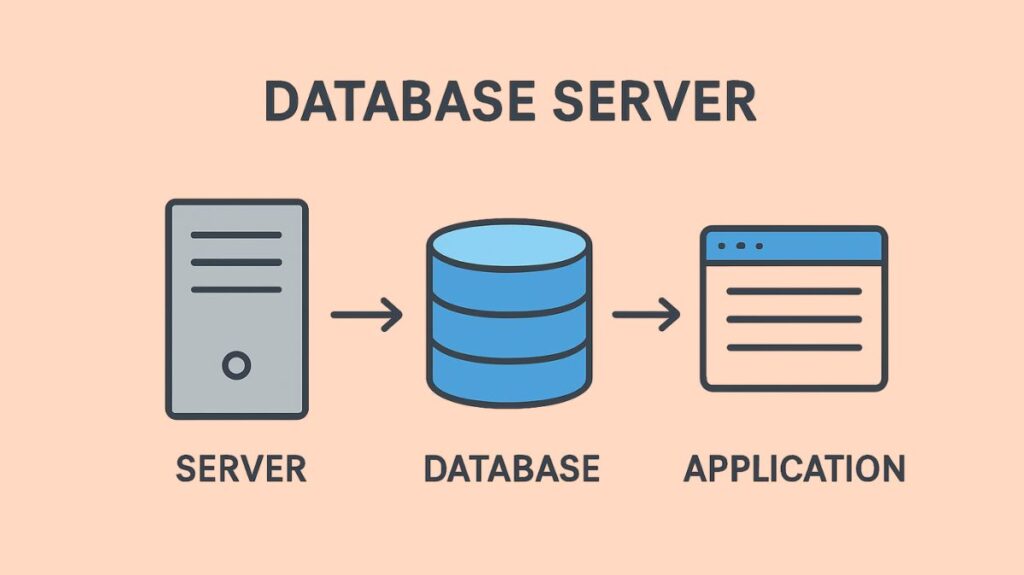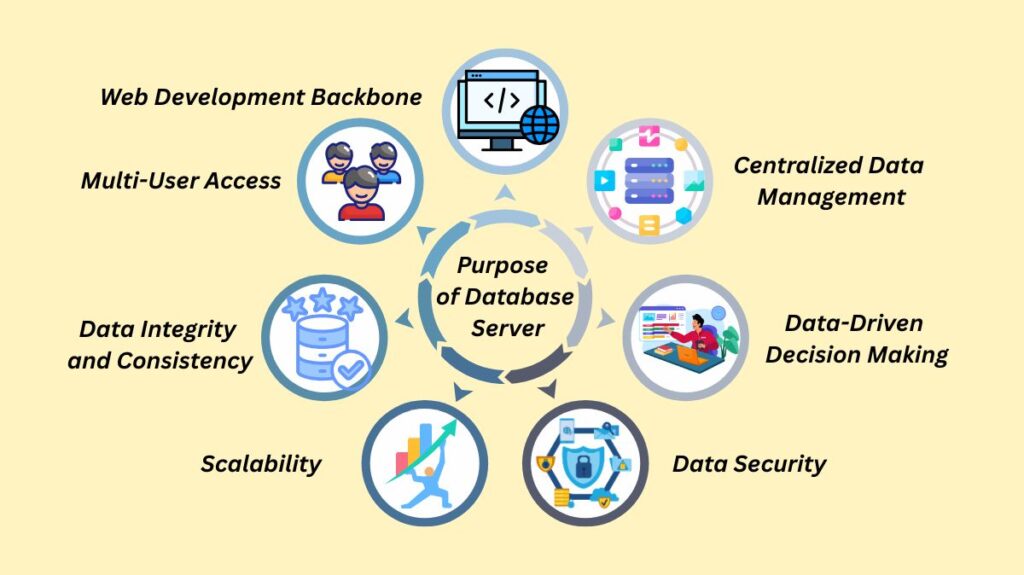In this article, we learn about what Database Server is, Purpose of Database Server, how a Database Server Works, features, and Examples of Database Server Software
Database Server

According to the client-server paradigm, a database server is a specialized computer system or software that uses a database application to offer database services to other computer programs or computers. It gives client systems access to business-critical data, making it an essential part of the client-server computing environment.
Consider a database server to be your data’s virtual librarian. Its main purpose is to effectively and safely store, manage, and retrieve vast volumes of structured data.
You can also read What is a Network Server, How it Works, Types and Components
What is a Database Server?
- A database server is a type of specialist server used for database management and access. It uses Database Management System (DBMS) software, which is the main application that manages all database functions, such as concurrency control, data integrity, and security.
- It serves as a centralized location to store organized information.
- The system enables numerous clients or programs to view the stored data and communicate with the database at the same time.
- Together, hardware and software make up a database server.
- The back-end database application, sometimes referred to as the database instance, is the software component that consists of a collection of background processes and memory structures that access database files.
- The server system that stores and retrieves data from databases is the hardware component; it is usually a specialized, high-end computer with a lot of memory and a lot of storage space to manage data efficiently.
Purpose of Database Server

Database servers play a crucial part in various applications and environments today.
Centralized Data Management: They remove duplication and inconsistency by offering a single, cohesive store for all organizational data.
Data-Driven Decision Making: They support effective data administration and aid in decision-making processes by enabling data analytics to discover trends and patterns.
Data Security: Database servers enforce access controls, use encryption, and implement authentication systems to protect sensitive data and meet corporate risk management standards.
Scalability: They are designed to handle increasing workloads and can scale to billions of records, offering solutions for growing networks.
Data Integrity and Consistency: They provide data accuracy and dependability with features like integrity limits, customizable verification, and adherence to ACID properties (Atomicity, Consistency, Isolation, Durability).
Multi-User Access: They enable simultaneous access to data for multiple users or applications, facilitating collaboration and real-time data access.
Web Development Backbone: In web development, they manage data storage and retrieval, ensuring dynamic content delivery and supporting interactive features for a responsive and personalized user experience.
How a Database Server Works
Database servers typically operate within a client-server architecture.
Client Request: A client application makes a request to the database server, such as a web browser, mobile app, or another software application. An administrative activity, retrieval, or modification (insert, update, or delete) may be the purpose of this request. Relational database queries are typically written in SQL, or Structured Query Language.
Connection Establishment: The database server establishes a connection with the client application, involving authentication and authorization to ensure the client has the necessary permissions.
Query Processing: The database server receives and parses the client’s request. The DBMS then creates an execution plan, determining the most efficient way to retrieve or manipulate data, often leveraging indexes and query optimization techniques.
Data Retrieval or Manipulation: The server executes the optimized query plan, reading data from disk, performing calculations, or applying filters. If data is modified, the server updates the database to maintain consistency.
Result Transmission: After the operation is finished, the database server returns the results to the client application, frequently in the form of individual values or tables.
Connection Closure: The connection may then be closed or maintained for further requests.
Clients can access a database server via a “front-end” application that displays the requested data or a “back-end” application that runs on the server and manages the database. The Open Database Connectivity (ODBC) standard provides the API that enables clients to call the DBMS.
You can also read What Is An Email Server? How It Work, Features And Functions
Key Functions and Features
Query Processing: Executes client queries using SQL or NoSQL queries.
Indexing: Uses specialized data structures to provide quick access paths to records, significantly improving query performance.
Query Optimization: Rewrites queries to improve efficiency.
Caching: Stores query results in memory for faster retrieval.
Concurrency Control: Manages simultaneous access by multiple users through mechanisms like locking and isolation levels.
Backup and Recovery: Provides mechanisms for regular data backups and disaster recovery to minimize downtime and data loss.
Data Abstraction: Offers users an abstract view of the data, concealing complex internal algorithms.
Transaction Management: Ensures that a series of operations either fully succeed or fail (Atomicity), maintaining data consistency.
Scalability: Supports techniques like sharding, which divides a large database into smaller parts (shards) for parallel processing and higher transaction volumes.
Examples of Database Server Software
Database servers can be broadly categorized, with various examples in each:
- Relational Database Servers (SQL): SQL servers manage structured data in tables with fixed schemas and associations. They manipulate and retrieve data with SQL.
- MySQL: An open-source relational DBMS widely used by web applications, known for reliability and scalability.
- PostgreSQL: An extensible, standards-compliant open-source object-relational DBMS that supports SQL and JSON querying.
- Microsoft SQL Server: Enterprises utilize Microsoft SQL Server, a proprietary RDBMS.
- Oracle Database (RDBMS): A powerful object-relational DBMS supporting large-scale applications and complex queries, widely employed in enterprise settings.
- MariaDB: A compatible MySQL fork with new features.
- IBM Db2: An established DBMS compatible with Windows, Linux, and UNIX systems.
- SAP HANA: A column-oriented relational DBMS designed for real-time analytics and applications.
- Teradata: Designed for large-scale data warehousing applications.
NoSQL Database Servers:
Manage unstructured or semi-structured data without a fixed schema, offering flexibility and scalability.
- MongoDB: A document-oriented NoSQL database useful for applications requiring high availability and scalability, storing data in adaptable JSON-like documents.
- Apache Cassandra: A distributed NoSQL database designed for large amounts of data across many servers with no single point of failure.
- Redis: An in-memory key-value store known for high performance and low latency, often used for caching.
- Apache CouchDB: An open-source NoSQL database using JSON for documents and JavaScript for MapReduce queries.
Cloud-Based Database Servers:
Hosted on cloud platforms (e.g., AWS, Azure, Google Cloud), offering scalability, flexibility, and managed database services. They can be relational or NoSQL.
- Amazon Aurora: A cloud-native relational database service that blends commercial database performance with open-source database simplicity. Aurora is used by Samsung for high-throughput, scalable applications.
- Firebase Realtime Database: A cloud-hosted NoSQL database featuring real-time client data synchronization. Google and other mobile app developers use it to construct dynamic apps.
- Snowflake: Cloud-based data warehousing that effectively stores and analyses large volumes of data. Snowflake powers sophisticated analytics and business insight for Capital One.
In-Memory Database Servers:
Store data primarily in RAM for extremely fast read and write operations. Examples include Redis and Memcached.
Embedded Databases:
Designed to be embedded within applications, operating within the same process without requiring a separate server.
- SQLite: A self-contained, serverless SQL database engine, lightweight and widely used in browsers and mobile devices.
- Firebird: An open-source RDBMS that can be embedded in applications.
While many databases are hosted on remote servers, it is possible to run a database server locally, particularly for development. Even “serverless databases” managed by cloud providers still rely on physical servers, though users do not manage them directly.
You can also read What Are The Different Types Of Web Servers And How It Works
